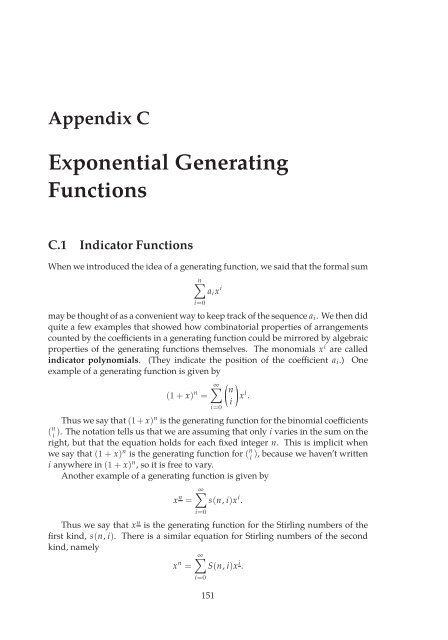Combinatorics Through Guided Discovery, 2004a
Combinatorics Through Guided Discovery, 2004a
Combinatorics Through Guided Discovery, 2004a
You also want an ePaper? Increase the reach of your titles
YUMPU automatically turns print PDFs into web optimized ePapers that Google loves.
Appendix C<br />
Exponential Generating<br />
Functions<br />
C.1 Indicator Functions<br />
When we introduced the idea of a generating function, we said that the formal sum<br />
n∑<br />
a i x i<br />
i=0<br />
may be thought of as a convenient way to keep track of the sequence a i . We then did<br />
quite a few examples that showed how combinatorial properties of arrangements<br />
counted by the coefficients in a generating function could be mirrored by algebraic<br />
properties of the generating functions themselves. The monomials x i are called<br />
indicator polynomials. (They indicate the position of the coefficient a i .) One<br />
example of a generating function is given by<br />
∞∑ ( ) n<br />
(1 + x) n = x i .<br />
i<br />
Thus we say that (1 + x) n is the generating function for the binomial coefficients<br />
( n ).<br />
i<br />
The notation tells us that we are assuming that only i varies in the sum on the<br />
right, but that the equation holds for each fixed integer n. This is implicit when<br />
we say that (1 + x) n is the generating function for ( n ),<br />
i<br />
because we haven’t written<br />
i anywhere in (1 + x) n , so it is free to vary.<br />
Another example of a generating function is given by<br />
∞∑<br />
x n = s(n, i)x i .<br />
i=0<br />
Thus we say that x n is the generating function for the Stirling numbers of the<br />
first kind, s(n, i). There is a similar equation for Stirling numbers of the second<br />
kind, namely<br />
∞∑<br />
x n = S(n, i)x i .<br />
i=0<br />
i=0<br />
151


















